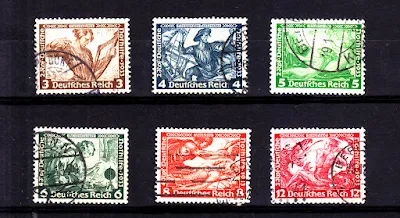The nine designs are as follows (in German):
04p + 02p - The Flying Dutchman.
05 p. + 02 p. - The Rheingold.
06 Pf. + 04 Pf. - Die Meistersinger von Nümberg.
08 pts + 04 pts - The Valkyrie.
12 pts + 03 pts - Siegfried.
20p + 10p - Tristan and Isolde.
25lbs + 15lbs - Lohengrin.
40lbs + 40lbs - Parsifal.
To my knowledge no updated stamp version(s) of Richard Wagner's operas have since been printed. This set was very scarce from the outset, largely because of the very low production figures. Only 265,000 sets were printed -- the lowest of all the Third Reich's commemorative stamp sets.Today, these stamps command a premium price amongst collectors in the philatelic world, especially the individual stamps of "Tristan und Isolde" (373,121 printed), "Lohengrin" (467,795 printed) and "Parsifal" (264,238 printed).
The set was designed by Alois Kolb (1875-1942). Printed by "Reichsdruckerei" (Berlin), using a recess printing method. There were two perforations runs: - Comb perforation, K 14: 13 (= type "A") - Comb perforation, K 14 (= type "B") These commemorative stamps were emergency aid issues. "Nothilfe", in German, literally means "emergency assistance". In the philatelic world, these types of postage stamps are known as "charity" or "semi postal" stamps,
The year 1933 also marked the 10th anniversary of the first German Nothilfe stamps of 1923, which had been issued to provide emergency aid to the victims of the Rhine-Ruhr floods during that year.Before this Third Reich issue, there was a Wagner-themed set released in Austria from 1926. These stamps, designed by Wilhelm Dachauer, depicted scenes either from "Der Ring des Nibelungen" or in the "Nibelungenlied". These stamps celebrated the first performances of "Die Meistersinger von Nürnberg" (in 1871) and "Siegfried" (in 1887) in the Czech Republic as well as depicting Wagner himself.Much has been written that Adolf Hitler was an admirer of Wagner's music and saw in his operas an embodiment of his own vision of the German nation;
Another Wagnerian-themed set was issued in 1943 from the Nazi-controlled Protectorate of Bohemia and Moravia.in a 1922 speech he claimed that Wagner's works glorified "the heroic Teutonic nature ... Greatness lies in the heroic." His favorite opera was "Die Meistersinger", and it is said that he could quote the entire opera from memory. Richard Wagner, while an extraordinary composer was also an avowed anti-Semite, which quite naturally curried favor with the Nazis. Despite his very public views on this topic, throughout his life Wagner had Jewish friends, colleagues and supporters.
Additionally, the Nazis used those parts of Wagner's thought that were useful for propaganda and ignored or suppressed the rest.While Wagner's Bayreuth Festspielhaus presented a useful front for Nazi culture, and Wagner's music was used at many Nazi events, the Nazi hierarchy as a whole did not share Hitler's enthusiasm for Wagner's mythological musings.
That said, Wagner's ideas were also amenable to socialist interpretations; many of his ideas on art were being formulated at the time of his revolutionary inclinations in the 1840s. Wagner's influence even on literature and philosophy is significant. The poets Charles Baudelaire, Stéphane Mallarmé and Paul Verlaine worshiped Wagner. And Friedrich Nietzsche was initially a member of Wagner's inner circle during the early 1870s, and his first published work, "The Birth of Tragedy", proposed Wagner's music as the Dionysian "rebirth" of European culture in opposition to Apollonian rationalist "decadence". And the list goes on.
Until his final years, Wagner's life was characterized by political exile, turbulent love affairs, poverty and repeated flight from his creditors. His controversial writings on music, drama and politics attracted extensive comment, not only in his lifetime but well into the 20th century. The effect of his influence spread beyond composition into conducting, philosophy, literature, the visual arts and theatre.


.jpg)
No comments:
Post a Comment